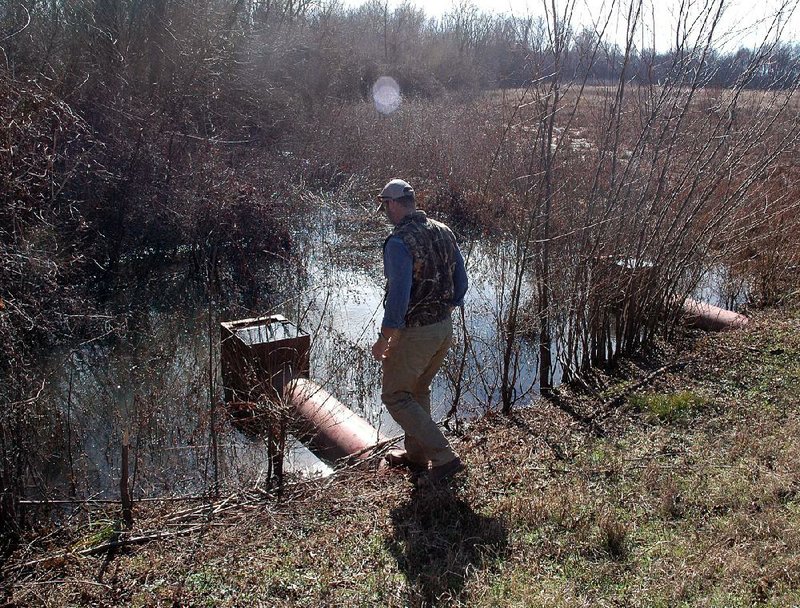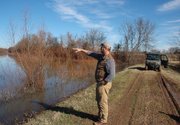Joel Whicker's daughter shot her first duck on a 20-acre impoundment built by the federal government on private land in Jefferson County.
Not far away, a black bear invaded and trashed an empty deer stand. A huge buck makes regular appearances on game cameras. Native grasses are thriving in otherwise empty fields, habitat in the making for the quail that Whicker and his fellow landowners hope to attract to the area.
"It's what it should be now," he said of the 6,000-acre stretch of Arkansas River Valley wetlands, parts of which were once farmland.
The land in southeast Pulaski and northwest Jefferson counties was part of an 11,200-acre tract that the U.S. Department of Agriculture added to the Wetlands Reserve Program in 2004. The voluntary initiative, now called the Agricultural Conservation Easement Program, is designed to help landowners restore marginal cropland to its original state and protect it from development.
"Wetland reserve easements provide habitat for fish and wildlife, improve water quality by filtering sediments and chemicals, reduce impacts from flooding, recharge groundwater and provide opportunities for educational, scientific and outdoor recreational activities," said Mike Sullivan, Arkansas state conservationist.
In the federal budget year that ended Sept. 30, USDA's Natural Resources Conservation Service added seven easements totaling about 6,000 acres in Arkansas, Sullivan said. He said the agency spent $18 million to acquire and restore those lands.
Randy Childress, assistant state conservationist, said a total of about 250,000 acres have been put into the program in Arkansas. Only Louisiana and Florida have more acres protected by federal easements, he said.
About $12.5 million is available now for acquisition of new easements in Arkansas during the current budget year, Childress said. He expects that total to increase to at least $15 million as other states turn back unused money.
Landowners interested in the program must apply to the Natural Resources Conservation Service by Jan. 29, the agency said in a news release. Both permanent and 30-year easements are available. In addition to private landowners, American Indian tribes, state and local governments and nongovernmental organizations that have farmland or grassland protection initiatives are eligible to participate in the program, the agency said.
Childress said lands added to the program remain the property of the owners, who continue to pay taxes on the property and retain the right to sell, trade or give away the acreage. Owners also continue to control access as well as the mineral rights and the ability to issue hunting leases.
There are restrictions, of course.
Only wetlands that were converted to cropland are eligible for the program, Childress said.
"We rough it back up to what it was prior to it being developed," he said.
That work can include building levees and shallow water retention structures as well as planting native trees and grasses, he said. Restoration efforts can take a year or more, Childress said, and after that the agency monitors the land to ensure it's not being farmed or used for other unauthorized purposes.
Childress stressed the Agricultural Conservation Easement Program is not solely about creating habitat for ducks. Wetlands are important for numerous species, he noted.
About 70 percent of the owners in the program are farmers, Childress said. He said an increasing percentage of applicants are families who want to preserve their land for recreational uses.
Whicker said he and the other five owners in his group don't lease their land to outside hunters and only lightly hunt it themselves. He said they take greater pleasure in swapping photographs captured by game cameras they have scattered across the property.
Whicker, who grew up on a cotton farm in Mississippi, said his biggest motivation for joining the easement program was to protect the land from development so that his children could enjoy it.
"Man is pretty smart, but he's also pretty destructive," said Whicker, a land and grain broker who also farms.
His group's property is inside the Arkansas River levee and remarkably varied. It includes thick clay and sandy soils, swamps and grasslands. A caretaker oversees the property, mowing the one-lane roads, disking the ground to encourage growth of varied types of vegetation, and controlling water levels in the impoundments, among other tasks.
And, on a recent mild afternoon, there were plenty of ducks.
SundayMonday Business on 01/03/2016



